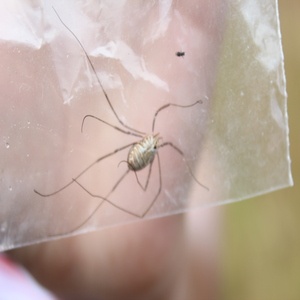'Not so Obvious Pond Creatures'
When you say the word "pond", and ask what organisms first come to mind, most people will respond with "mosquitoes", "fish" or "ducks". Although these are animals that have an important role in an aquatic food web, there are others creatures that are not so obvious pond organisms.
The Nosehill pond area has a noticeable population of dragonflies visible to the eye. Dragonflies insects characterized by their large multifaceted compound eyes, elongated body, and their two pairs of transparent wings. They are considered valuable predators due to the fact that they consume mosquitoes, flies, bees, wasps, ants, and other insects. You may wonder then, why is a dragonfly a pond organism? A dragonfly's life span can range from 2 years to 6 years, but little of it is actually spent as an adult dragon fly.
Figure 1. Dragonflies mating
That's because there are three stages to the life cycle. The first is the egg. The egg is laid a female after she has mated with a male in mid-air. This generally occurs near a body of water. The female will want to lay the egg on a plant in the water, or if she cannot find a suitable place, she'll just drop them straight into the water.
The next stage of a dragonfly's life cycle is the nymph stage. The nymph is the immature form of vertebrates, particularly insects. The dragonfly nymph is an aquatic larva, meaning it lives and develops in the water until it is ready to turn into a mature dragonfly. This stage can last to about 4 years. As a nymph, the dragonfly is prey to fishes such as trout and bass, water boatmen, and sometimes leeches. Preys to the nymph include tadpoles, young fishes, cyclops, scuds, beetles, water lice, and water fleas.
Figure 2. Generalised food chain with algae as producer, scuds as primary consumer, dragonfly nymph as secondary consumer, and water boatmen as tertiary consumer.
As you can see, the dragonfly nymph plays a major role in a pond ecosystem, both as a predator, and a prey. Once the nymph is ready for metamorphosis, it will crawl out of the water and onto the stem of a plant. There it will shed its skin and become a young dragonfly. Adult dragonflies only live for about two months. This means that the majority of its life is spent as a pond creature feeding and feeding on other aquatic organisms.
Figure 3. Adult dragonfly
Another organism which is not immediately associated with the pond ecosystem are spiders. On our expedition at Nosehill park, we spotted a large variety of spiders scuttering in the long grass around the pond, one even crawled into our box of water testing equipment. The two species of spiders we successfully identified were the “daddy long-legs” and the “flower crab spider”.
Daddy longlegs are formally called Opiliones or Harvestmen, the term daddy longlegs is commonly associated with other unrelated arthropods: The crane fly ,and the cellar spider. Opiliones are omnivores that can eat plant material, small insects, fungi, and dead material which are all abundant in the pond ecosystem area.
Daddy longlegs are formally called Opiliones or Harvestmen, the term daddy longlegs is commonly associated with other unrelated arthropods: The crane fly ,and the cellar spider. Opiliones are omnivores that can eat plant material, small insects, fungi, and dead material which are all abundant in the pond ecosystem area.
Figure 4. Daddy long legs spider in Ziploc bag.
The other spider we identified was the flower crab spider, a small white spider no larger than 5mm in diameter. This spider is quite common in Alberta and relies on flower ambushing to catch prey; its white or yellow color allows it to camouflage in the petals of white or yellow flowers where it sits in wait for unsuspecting honeybees. They are also part of the pond ecosystem because they prey on bees that pollinate the flowers of the plants that are in and around the pond. Without these bees, there would be no plants to provide shelter for the variety of nymphs and larvae that are developing in the waters of the pond.
Although these two spiders are not directly connected to the pond’s organisms, Dolomedes – a spider that preys on aquatic invertebrates – can be integrated into the pond ecosystem’s food chain.
Figure 5. Generalised food chain with algae as producer, mayfly as primary consumer, spiders as secondary consumer, and birds as tertiary consumer.
There are a lot more organisms that you may have thought existed in a pond ecosystem. Even though some animals are not directly living in the aquatic environment itself, they are still related because they are part of the pond food chains and webs. Acting as consumers and a food source, dragonflies and spiders are only some of the examples of organisms that are 'not so obvious pond creatures'.






No comments:
Post a Comment
Note: Only a member of this blog may post a comment.